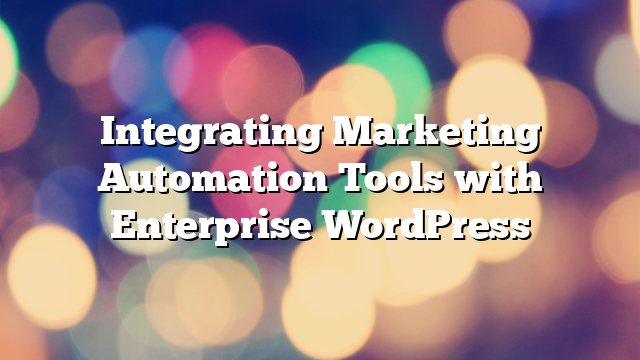Integrating Marketing Automation Tools with Enterprise WordPress
23.04.2025

In today’s digital-first business environment, marketing automation is not just a luxury—it’s a necessity. For enterprise organizations using WordPress as a core content management system, integrating marketing automation tools like HubSpot, Marketo, Salesforce Marketing Cloud, or Mailchimp can significantly enhance lead generation, conversion tracking, and customer engagement. But doing it right requires planning, technical expertise, and a scalable approach.
Why Enterprises Need Marketing Automation Integration
Enterprise websites often serve as the primary customer touchpoint, hosting everything from landing pages to product documentation and customer portals. By connecting WordPress to powerful marketing automation platforms, companies can:
- Track user behavior and segment audiences in real time
- Automate follow-up emails and nurture campaigns
- Score leads based on website interactions
- Deliver personalized content based on CRM data
These capabilities turn a passive website into an active marketing engine.
Choosing the Right Tools for Your Stack
The right automation tool depends on your organization’s scale, existing CRM, and campaign goals. HubSpot, for example, offers a seamless plugin for WordPress with native forms, CTAs, and analytics. Meanwhile, Marketo or Salesforce might require more custom integrations using APIs or middleware such as Zapier or Make (formerly Integromat).
Methods of Integration
There are three main ways to integrate marketing automation platforms with WordPress:
1. Plugin-Based Integration
Many tools offer official or third-party plugins that simplify the integration. These are ideal for rapid deployment and basic functionality like embedding forms or tracking user behavior.
2. API Integration
For enterprises that require deep customization, leveraging the APIs of marketing platforms provides complete flexibility. Developers can sync user actions, form submissions, or even custom post type data with external systems in real time.
3. Webhooks and Middleware
Using automation platforms like Zapier or Make allows enterprises to create workflows without writing code. For example, a new form submission in WordPress can trigger a webhook that adds the contact to a Mailchimp list and sends a Slack notification to the sales team.
Best Practices for Integration
- Data Mapping: Ensure that all form fields and user data align correctly between WordPress and your automation tool.
- GDPR Compliance: Always include opt-in checkboxes and ensure user data is handled according to data protection laws.
- Performance Monitoring: Use asynchronous scripts and caching to prevent integration scripts from slowing down the site.
- Fail-Safes: Add fallback mechanisms to store form data locally in case of API errors.
The Result: Smarter Marketing with Less Effort
When properly implemented, a marketing automation system connected to WordPress does more than track visitors—it creates a responsive, intelligent workflow that turns visitors into leads and leads into loyal customers. This allows enterprise marketing teams to scale their efforts while maintaining a personal touch across all digital channels.
Conclusion
Marketing automation integration is a game-changer for enterprises using WordPress. Whether you choose plug-and-play plugins or custom API development, the results are the same: more efficiency, deeper insights, and improved ROI. If your organization is ready to evolve its marketing engine, this is the time to invest.
Need help integrating marketing automation with your enterprise WordPress website? Vipe Studio specializes in API integrations and advanced enterprise solutions. Reach out to us today via our contact form and let’s make your marketing workflow smarter.



